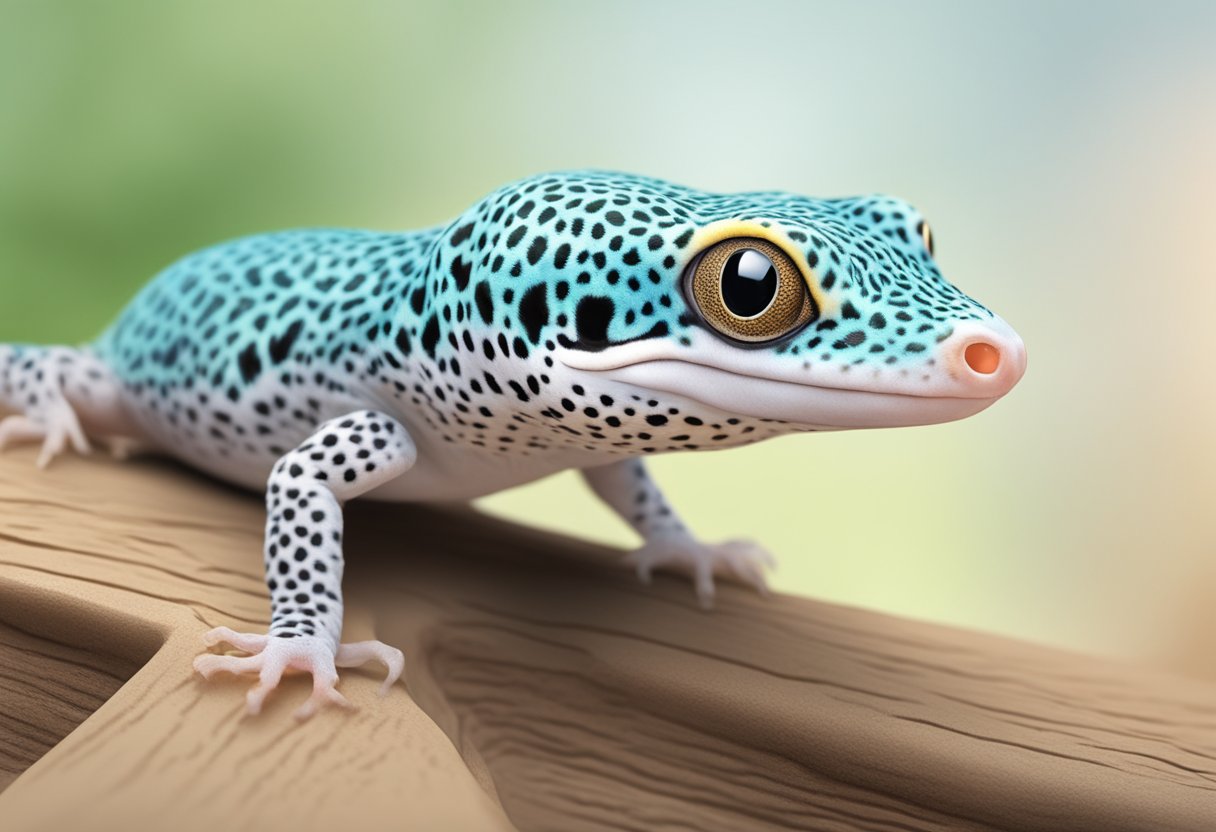Leopard geckos are popular reptiles in the pet trade, known for their unique coloration and patterns. As owners become more familiar with these fascinating creatures, understanding their reproductive biology is essential. A crucial component of the leopard gecko’s reproductive process is the sperm plug. This formation plays a significant role in their mating cycle and can also indicate the health of your gecko.

Sperm plugs are gelatinous structures found in male leopard geckos and are a result of the solidification of excess sperm within the reproductive tract. These plugs can be expelled from the body as part of a natural cleansing process. For owners, it is essential to be aware of the presence of sperm plugs, as they can indicate that your gecko is sexually mature and ready to breed.
It is also worth noting that the presence of sperm plugs may have implications for your leopard gecko’s health and wellbeing. Proper management of sperm plugs is necessary to ensure your gecko remains in top condition.
Key Takeaways
- Sperm plugs are an integral aspect of the leopard gecko’s reproductive cycle
- Detecting the presence of sperm plugs allows owners to verify their gecko’s sexual maturity
- Proper sperm plug management is crucial for maintaining your gecko’s health and wellbeing
Understanding Leopard Gecko Biology
Leopard geckos are fascinating creatures that require specific care and attention. One crucial aspect of their biology is the presence of sperm plugs. To properly care for your leopard gecko, it’s essential to be familiar with this aspect of their reproductive system.
Sperm plugs are formed by the male leopard gecko during the breeding season to prevent sperm leakage. They are expelled from the hemipenes, the male’s reproductive organs, and may be found in the gecko’s environment or enclosure. This is a natural and normal occurrence for male leopard geckos.
Recognizing a sperm plug can help you identify the sex of your gecko and monitor its health. Appearance of sperm plugs can vary, but they are typically:
- White or yellowish in color
- Waxy or rubbery in texture
- Tubular or cylindrical in shape
It is essential to keep an eye on your gecko’s overall health. If you notice any unusual behavior or if your gecko appears to be in pain when expelling a sperm plug, it is essential to consult a veterinarian specializing in reptile care.
By understanding key aspects of leopard gecko biology, such as sperm plugs, you can ensure your gecko remains healthy and happy for years to come.
Concept of Sperm Plug
Sperm plug is a common term used in the world of reptile breeding, especially for leopard geckos. It refers to a small, waxy secretion from the male gecko’s hemipenes. This secretion helps to seal the sperm inside the female’s reproductive tract after mating. Here are some key points about sperm plugs in leopard geckos:
- They are solidified secretions that ensure the sperm stays in place.
- Typically, they are white to off-white in color and can be easily spotted during husbandry tasks.
- A sperm plug sighting might suggest that your leopard gecko is sexually mature.
- If you notice one, it is essential for you to monitor the gecko’s health and be aware of potential breeding behaviors.
Sperm plugs can present some challenges for leopard gecko breeders. For instance, they can indicate the potential for male aggression and territorial behaviors, which may complicate the breeding process. To avoid unnecessary stress, keep an eye out for these warning signs and make appropriate adjustments to your husbandry practices.
Keep in mind the importance of proper habitat maintenance and optimal environmental conditions, as these factors can significantly impact the breeding success of your leopard gecks. Ensuring a healthy environment will minimize any risks associated with the formation of sperm plugs and contribute to a successful breeding experience.
Leopard Gecko Reproduction Cycle
Leopard geckos are unique reptiles known for their striking colors and patterns. They go through a specific reproduction cycle that involves several stages. Knowing these stages will help you understand your leopard gecko’s needs and behavior during breeding seasons.
Pre-breeding preparation is an important part of the cycle. As a pet owner, you should create a comfortable environment by providing appropriate:
- Temperature gradients
- Humidity levels
- Hiding spots
- Nutrients
Proper care ensures the highest chances of successful reproduction.
Mating occurs when females reach sexual maturity, typically between 8 to 12 months. Males exhibit courting behavior, such as tail wagging and gentle biting. Successful copulation often ends with a display of the male’s hemipenes, which carry sperm to the female. It is important to monitor for any signs of distress or aggression during this time.
Fertilization takes place internally. Females store sperm from multiple partners, which can be used to fertilize several clutches of eggs throughout the season. Keep an eye out for:
- Weight gain in females
- Gravid behavior, such as digging
- Loss of appetite
Egg laying usually happens within 16 to 30 days after mating. Females lay two eggs per clutch, with an average of four to six clutches per breeding season. Here are some considerations for egg care:
- Provide a suitable lay box with moist substrate for easy digging.
- Incubate eggs at optimal temperature (usually 79-89 degrees Fahrenheit) and humidity (70-80%).
- Mark the top side of the egg to prevent rotation, which can harm the developing embryos.
Finally, egg hatching occurs. Allow hatchlings to emerge independently to reduce the risk of injury. Provide a suitable habitat and proper care to ensure healthy development and growth.
Understanding these stages will help you successfully breed your leopard geckos and enjoy the process with minimal complications.
Role and Formation of Sperm Plugs
Sperm plugs play a crucial role in the reproductive cycle of leopard geckos. They are gelatinous, solidified secretions from the male’s reproductive system, which serve to seal the female’s cloaca to prevent her from mating with other males. This sealing ensures that the sperm from the first male has a higher chance of fertilizing the female’s eggs.
The formation of sperm plugs begins during the mating process, when the male leopard gecko inserts one of his hemipenes, a bifurcated sexual organ, into the female’s cloaca. Once the male has released sperm into the female, a fluid produced by his hemipenal bulge solidifies, creating the sperm plug.
Some key aspects of sperm plugs in leopard geckos include:
- They are typically discovered during cleaning of the gecko’s enclosure.
- Sperm plugs can be confused with fecal matter or other debris, but their distinctive appearance should help differentiate them.
- Proper identification of a sperm plug can be beneficial for breeders, as it may indicate a successful mating process.
In summary, sperm plugs are important structures supporting the reproductive success of leopard geckos. They are formed during mating and serve to improve the chances of the initial male’s sperm reaching the female’s eggs by sealing her cloaca and preventing further insemination from other males. Understanding and identifying sperm plugs can provide useful insights into the reproductive health and breeding success of these reptiles.
Determining the Presence of Sperm Plug

Sperm plugs in leopard geckos can be an indication of successful breeding. To ensure you accurately identify the presence of sperm plugs, consider the following steps:
- Observe the gecko’s behavior: Males may display noticeable behavioral changes such as increased activity, increased appetite, and aggression towards other geckos during the breeding season. Males may also perform courtship displays, such as tail-waving and chirping.
- Examine the cloacal area: The presence of sperm plugs can be detected by carefully inspecting the gecko’s vent area. This is located beneath the tail, just above the base. In the presence of a sperm plug, you may notice a small, hardened, white or yellowish mass protruding from the vent.
- Record your findings: Keep track of the dates and findings of your inspection. This can help you monitor the breeding progress and keep an accurate record of the gecko’s reproductive health.
Some tips to help you with the process:
- Ensure the gecko is comfortable and secure during the examination. Holding its body with a gentle yet firm grip can help achieve this.
- Use a magnifying glass or a smartphone camera zoom feature if you’re having difficulty seeing the vent area clearly.
- Remove any leftover sperm plugs carefully by using a pair of blunt tweezers or a cotton swab, taking care not to damage the gecko’s delicate skin.
Remember, it’s crucial to monitor your leopard gecko’s health regularly and seek expert advice if you have any concerns or questions about their reproductive health.
The Impact of Sperm Plugs on Leopard Gecko Health
Leopard geckos are known for producing sperm plugs that may impact their health. You may notice this when cleaning your gecko’s enclosure. Understanding the implications is crucial to ensure your pets’ well-being.
Sperm plugs are firm, whitish discharge that male leopard geckos produce. It serves as a protective barrier to the reproductive tract, ensuring the sperms’ viability. As a gecko owner, it is essential to monitor these plugs and their potential effects on your pet’s health.
Various factors influence the development of sperm plugs. Seasonal periods of breeding can often trigger increased plug production. Additionally, individual hormonal imbalances and environmental factors might contribute to excessive plugs.
In most cases, sperm plugs do not harm your leopard gecko’s health and can be managed easily. However, sometimes complications may arise:
- Impaction: If not expelled, sperm plugs can lead to impaction issues, causing pain, discomfort, and more severe health problems.
- Infection: Ignored or improperly removed plugs may cause infection in the cloacal area, which can be harmful to your gecko.
As a responsible pet owner, there are steps you can take to minimize the risks associated with sperm plugs:
- Regular Monitoring: Check for sperm plugs frequently, especially during the breeding season.
- Proper Enclosure Maintenance: Clean the enclosure regularly to prevent excessive humidity and bacteria build-up.
- Consult a Veterinarian: Seek professional advice if you notice any signs of infection or impaction.
By following these measures and addressing issues promptly, you can ensure your leopard gecko remains healthy despite the presence of sperm plugs.
Expert Tips on Sperm Plug Management
Leopard gecko sperm plugs can be concerning for new and experienced owners alike. These plugs, formed as males discard old sperm, are a natural part of their reproductive process. Managing them properly can ensure your gecko’s health and comfort. Here are some expert tips to help you:
- Familiarize yourself with sperm plugs: It’s essential to know what you’re dealing with. Sperm plugs often look like white or off-white, small, waxy blobs. They are typically found near the gecko’s cloacal area.
- Establish a routine inspection: Regularly check your male leopard gecko’s vent area–ideally once a week–for the presence of sperm plugs. Early detection and removal can prevent complications or discomfort.
To manage sperm plugs effectively, follow these guidelines:
- Keep your gecko’s environment clean and well-maintained. A hygienic living space can minimize the risk of impaction or infection associated with sperm plugs.
- Keep an eye on your gecko’s behavior. If they seem stressed or are excessively licking their vent region, it may indicate the presence of a sperm plug.
- To remove a visible sperm plug, use a damp cotton swab or disposable glove to gently pull the plug, ensuring not to cause any harm to your gecko.
- If you struggle to remove a sperm plug or notice signs of infection, consult a reptile veterinarian for professional help.
By following these expert tips on sperm plug management, you can confidently maintain your leopard gecko’s health and well-being. Remember to always pay close attention to your gecko’s behavior and appearance to detect any potential issues early on.
